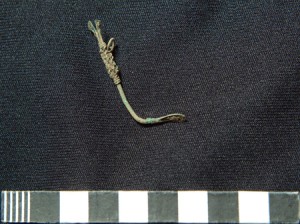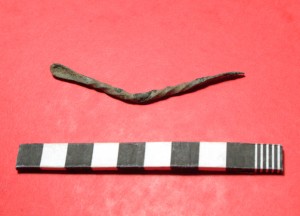We like to think that the modern world is sophisticated and far more advanced than our predecessors. When it comes to health and hygiene is this always true? Most of us will have experienced troublesome ear wax and it has probably been a problem throughout history. What do we do about it? Today we would probably use cotton wool buds or apply almond oil on cotton wool, if it does not clear go to the doctors to have our ears syringed. In the past there were ear scoops examples of which have been found to be in use from Roman times.
 In the archaeological exploration in the former East Kirk of St Nicholas a beautiful ear scoop was found and is shown in the photograph to the right. This one has an intricately decorated shaft and near the end opposite to the scoop is a suspension loop. The latter may well have been used to fasten it to a collection of other cosmetic ‘tools’ such as scissors and tweezers, perhaps from a belt. The scales in the photographs have 1 cm divisions.
In the archaeological exploration in the former East Kirk of St Nicholas a beautiful ear scoop was found and is shown in the photograph to the right. This one has an intricately decorated shaft and near the end opposite to the scoop is a suspension loop. The latter may well have been used to fasten it to a collection of other cosmetic ‘tools’ such as scissors and tweezers, perhaps from a belt. The scales in the photographs have 1 cm divisions.
 A second ear scoop was also found during the dig was a much plainer example. It can be seen in the second photograph that there is very little decoration, but it does have the short point at the opposite end to the scoop. This is similar to most ear scoops found in digs at other places in the UK. The sharpened point at the opposite end to the scoop was probably used as a tooth pick.
A second ear scoop was also found during the dig was a much plainer example. It can be seen in the second photograph that there is very little decoration, but it does have the short point at the opposite end to the scoop. This is similar to most ear scoops found in digs at other places in the UK. The sharpened point at the opposite end to the scoop was probably used as a tooth pick.
Why it was felt appropriate to include these items in burials? Or did they get into the soil some other way? This is open to speculation, but we can be grateful that we are able to enjoy the small but fascinating and beautiful object centuries later. A short health warning should be added. Inserting metal objects into the ear risks damaging the ear drum and so should be avoided. Remember the old adage “never put anything in your ear smaller than your elbow”!
(The photographs are copyright Aberdeen Art Gallery & Museums Collections and are used with permission).